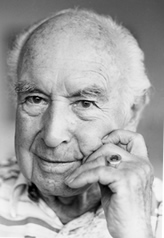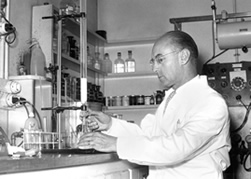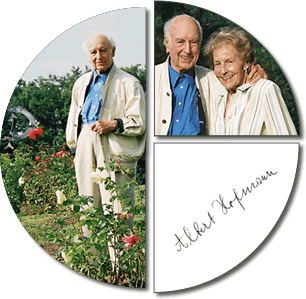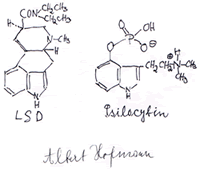
Albert Hofmann
The committee has awarded this years Hofmann Award to Professor Christopher Chang.
Award 2015
Albert Hofmann (1906 - 2008)
Albert Hofmann was born in Baden (Aargau), Switzerland in 1906. In 1925 he began his studies in Chemistry in the Institute of Organic Chemistry at the University of Zürich.
In 1929 he finished his graduation on the enzymatic degradation of chitin and chitosan (Karrer P., Hofmann A., Helv. Chim. Acta (1929), 12, 616-637 [ pdf ] ) in the laboratory of Paul Karrer.

From 1929 to 1971, he dedicated himself to the research into the chemistry on natural products. During this period he worked in the
pharmaceutical laboratories in the Sandoz AG company in Basel (now Novartis).
His research was directed towards identification and synthesis of biological active natural compounds from Scilla maritima of the family Liliaceae, from several species of Rauwolfia of the family Apocynaceae (also called dogbane family) as well as from the fungi Claviceps purpurea and Psilocybe mexicana. It was his work on ergot alkaloids isolated from Claviceps purpurea, the causative agent of ergot in cereals (Secale cornutum) which made him wordwide known.
In 1938, he synthesized for the first time the LSD-25, by working on the central common component of ergot alkaloids isolated from Claviceps purpurea, the lysergic acid. Five years later, Dr Hofmann discovered the psychedelic effects of LSD after accidentally ingesting some through his fingertips. His book "LSD My Problem Child" recounts much of the history that developed after this fateful event.
He became director of the natural products department at Sandoz and went on studying hallucinogenic substances found in Mexican mushrooms and other plants used by the aboriginal people. This lead to the synthesis of psilocybin, the active agent of many "magic mushrooms". [ video  ]
]
Albert Hofmann became interested in the seeds of the Mexican magic morning glory species Rivea corymbosa, the seeds of which are called Ololiuhqui by the natives. He was very surprised to find the active compound of Ololiuhqui chemically very similar to LSD.
In 1962, he and his wife Anita travelled to southern Mexico to search for the magic plant ska Maria Pastora (leaves of Mary the shepherdess), later known as Salvia divinorum. He was able to obtain samples of this plant but never succeeded in identifying its active chemicals.

Dr. Dr. h.c. mult. Albert Hofmann is Fellow of the World Academy of Sciences, Member of the International Society of Plant Research and the American Society of Pharmacognosy.
He has been author of over 100 scientific articles and has written (or co-authored) a number of books, including LSD, My Problem Child (mentioned above), which is partly an autobiography and describes his famous bicycle ride.
From this research arose highly valued drugs like Methergin and Hydergin, which are still used clinically today.
The Organic Chemistry Institute of the University of Zurich is proud to honor an outstanding alumnus on the occasion of his centennial birthday. His fame extends around the globe and in addition to our award symposium on January 27th, there will be an international symposium on the 13th of January in Basel; the January 2006 issue of Chemstry World devotes the cover article to him.
Happy Birthday Albert!!!


